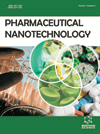- Home
- A-Z Publications
- Pharmaceutical Nanotechnology
- Previous Issues
- Volume 11, Issue 2, 2023
Pharmaceutical Nanotechnology - Volume 11, Issue 2, 2023
Volume 11, Issue 2, 2023
-
-
Nanoformulation-based Drug Delivery System for Viral Diseases
More LessViral diseases are one of the major causes of mortality worldwide. The emergence of pandemics because of the COVID virus creates a dire need for an efficient mechanism to combat the disease. Viruses differ from other pathogenic infections; they render the host immune system vulnerable. One of the major challenges for developing antivirals is the resistance developed by the overuse of drugs, which is inevitable as most vir Read More
-
-
-
Current Research on Spray-Dried Chitosan Nanocomposite Microparticles for Pulmonary Drug Delivery
More LessUsing the pulmonary route for systemic and local drug delivery is an attractive method of drug administration because it has a high alveolar surface area, abundant blood flow, a thin airblood barrier, and low metabolic activity. In recent years, the evolution of inhalable chitosan nanocomposite microparticles formulations enabled researchers to develop new pulmonary drug delivery platforms that combine the a Read More
-
-
-
Solid Lipid Nanoparticles (SLNs): Advancements in Modification Strategies Toward Drug Delivery Vehicle
More LessSolid lipid nanoparticles are at the cornerstone of the swiftly growing area of medical nanotechnology, having several potential functions in drug delivery, research, clinical care, and a variety of other fields. They provide the opportunity of developing novel therapies due to their unique properties, such as small particle size and being prepared from physiological biodegradable lipids. The loading of bioactive molecules int Read More
-
-
-
Magnetophoretic Intranasal Drug-loaded Magnetic Nano-aggregates as a Platform for Drug Delivery in Status Epilepticus
More LessAuthors: Ali Hemmat, Erfaneh Ghassami, Mohsen Minaiyan and Jaleh VarshosazBackground: Status epilepticus is associated with substantial morbidity and neuronal necrosis, and the duration of the seizure would affect its following complications. Eliminating the duration would have valuable outcomes; however, the presence of BBB is an obstacle. The purpose of the current study was to achieve a nose-to-brain magnetic drug delivery system to accelerate the onset of action, and to reduce the mucoci Read More
-
-
-
Effect of the Surfactant Charge on the Characteristics and Anticancer Effects of Docetaxel-loaded Poloxamer Polymeric Micelles
More LessAuthors: Dwianto Harry Nugraha, Kusnandar Anggadiredja and Heni RachmawatiBackground: The main problem in the use of docetaxel as a potent chemotherapeutic agent is its solubility. Practically insoluble docetaxel requires a harsh formulation with high surfactant and alcohol concentrations to comply with the product quality. However, this formulation is inconvenient for patients. Polymeric micelles using a biocompatible polymer, poloxamer, seem to be a promising approach to increase the solubility o Read More
-
-
-
Biogenic Synthesis of Silver Nanoparticles using Lasiosiphon eriocephalus (Decne): In vitroAssessment of their Antioxidant, Antimicrobial and Cytotoxic Activities
More LessAuthors: Kailas D. Datkhile, Pratik P. Durgawale and Satish R. PatilIntroduction: The emergence of novel nanobiomedicine has transformed the management of various infectious as well as non-infectious diseases. Lasiosiphon eriocephalus, a medicinal plant, revealed the presence of active secondary metabolites and biological potentials. Objective: The present study was aimed to demonstrate the biosynthesis of silver nanoparticles using L. eriocephalusleaf extract (LE-AgNPs) and their b Read More
-
-
-
Experimental Pharmacology for COVID-19 Treatment: A Geoanalytical Bibliometric Analysis
More LessAuthors: Cesar Aguado and Victor M. CastañoObjective: The objective of this study is to produce a geo-referenced map of the status of R in COVID-related studies in the world. Methods: Spatial mapping of bibliometric data of Cortellis Drug Discovery Intelligence through a spatial bibliometric model with the aid of a GIS (Geographic Information System) called ArcGIS and the software. Results: We show the countries that have the most studies related to COV ID-19 an Read More
-
-
-
The Antibacterial Effect of Tetracycline-loaded Mesoporous Silica Nanoparticles in the Gingival Fluid at Implant-abutment Junction: A Randomized Clinical Trial Study
More LessIntroduction: Dental implant failure due to periodontal disease caused by anaerobic pathogens occurs, especially in the first year of implant placement. The aim of this clinical trial study was to compare the antibacterial effect of tetracycline gel and gel containing tetracyclineloaded mesoporous silica nanoparticles (MSNs) in the gingival crevice fluid of the implantabutment junction as a randomized clinical trial study. Read More
-
Most Read This Month
Article
content/journals/pnt
Journal
10
5
false
en


